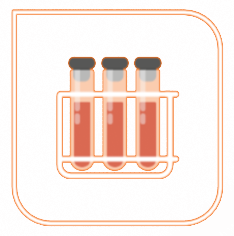

PeliClass sheep anti human IgG2
Kit for quantitative determination of human IgG subclasses in serum and plasma on the Beckman IMMAGE / IMMAGE 800.
| Article number | M1892 |
| Product group | IgG subclasses IMMAGE |
| Technique | Nephelometry/turbidimetry |
General information
Human IgG is a crucial component of our immune system, composed of four distinct subclasses: IgG1, IgG2, IgG3, and IgG4. Extensive research 1-5 has meticulously detailed the biochemical attributes that set apart these IgG subclasses. These disparities give rise to a range of pivotal biological functions, including vital roles in antigen recognition, activation of complement pathways, and binding to receptors on cell surfaces.
Numerous investigations have shed light on the profound impact of IgG subclass imbalances on human health 6. Notably, an intriguing connection has been established between selective IgG2 subclass deficiency and heightened vulnerability to viral and bacterial infections—a link that has been well-documented 4,5. Instances of diminished serum levels of IgG2 or IgG3 have been notably associated with patients prone to recurring upper and lower respiratory tract infections. Furthermore, compelling evidence has surfaced indicating that individuals with markedly low IgG4 serum concentrations exhibit a predisposition to recurrent sino-pulmonary infections 7.
Beyond infections, perturbations in IgG subclass serum levels have emerged as significant markers in diverse health conditions, spanning autoimmune diseases, neurological disorders, and even HIV infections 4,6. These findings underscore the far-reaching impact of IgG subclasses on our immune responses and overall well-being.
Test principles
Designed to deliver swift, consistent, and accurate quantification of human IgG subclasses (IgG1, IgG2, IgG3, and IgG4), the PeliClass Human IgG Subclass Plus Kit sets a new standard in diagnostic precision.
The nephelometric assessment of IgG1 and IgG2 concentrations in serum is grounded in a targeted interaction with a monospecific anti-IgG subclass antiserum, ensuring both reliability and specificity. Meanwhile, the turbidimetric analysis of IgG3 and IgG4 levels in serum employs a specialized latex reagent, coated with highly avid anti-IgG subclass antibodies, enhancing analytical sensitivity for enhanced accuracy.
To achieve utmost specificity, the fractionated sheep anti-human IgG subclass sera are meticulously refined through absorption techniques, eliminating unwanted IgG subclasses via isolation of gammaglobulins. Further refinement involves absorption with isolated serum fractions, a process meticulously outlined in references 8-10.
Crafted with meticulous attention, the polyclonal reagents within this kit have been meticulously chosen for their exceptional affinity toward human IgG subclasses. Both nephelometric and turbidimetric quantifications leverage the formation of immune complexes, quantified by measuring scattered light and transmitted light, respectively.
Your test samples’ IgG subclass concentrations are skillfully determined by comparing them to a reference curve, meticulously constructed with the provided IgG subclass calibrators. An added layer of quality assurance is delivered through IgG subclass control sera, meticulously evaluated to verify the integrity of the reference curves and the precision of IgG subclass determinations.
For precise calibration, the IgG subclass levels within the calibrators were ascertained utilizing ERM-DA470 as the calibration standard. The assigned values—6.210 g/L for IgG1, 3.450 g/L for IgG2, 0.390 g/L for IgG3, and 0.591 g/L for IgG4—draw from WHO 67/97 11, ensuring accuracy that you can trust.
Storage and stability

All the components of the kit remain stable until the expiration date indicated on the label when stored at 28°C. It’s important to note that transportation conditions may be different from storage conditions. The IgG3 and IgG4 latex reagents should not be frozen.
Once opened, the components can be stored at 2-8°C for one month, considering the expiration date on the label. After completing the daily workload, make sure to return the components to 28°C. Before storing the reagent cartridges, replace the evaporation caps with screw caps to prevent evaporation.
The calibration curves remain stable for at least one month, but it’s always recommended to use control sera to verify the accuracy of the calibration curves.
Package contents
Quantify all four human IgG subclasses accurately with the PeliClass Human IgG Subclass Plus Kit, offering 50 tests with calibrators and controls included. For individual components listed in the initial package insert, separate orders are possible.
|
Sheep antibodies against human IgG1 |
1x 2.4 mL |
M1891 |
|
Sheep antibodies against human IgG2 |
1x 2.9 mL |
M1892 |
|
Latex enhanced sheep antibodies against human IgG3 |
1x 4.0 mL |
M1893 |
|
Latex enhanced sheep antibodies against human IgG4 |
1x 4.0 mL |
M1894 |
|
Human IgG subclass calibrator set |
7x 1.0 mL |
M1896 |
|
Human IgG subclass control 1 |
1x 1.0 mL |
M1897 |
|
Human IgG subclass control 2 |
1x 1.0 mL | M1898 |
Precautions
The calibrators and controls consist of liquid human sera, assessed for specific disease markers in line with EU guidelines to GMP, yielding nonreactive results. However, due to their human origin, all components carry potential infection risk. Adhere to lab regulations for waste disposal.
Note that the reagent cannot be guaranteed free from infectious agents. Store all components at 2-8°C until the specified expiry date; transport conditions might vary. Take caution to avoid freezing the IgG3 and IgG4 latex reagents.
Test sample handling
The assay accommodates serum and plasma (EDTA and Na-heparin). It’s recommended to test fresh samples or store at 2-8°C. For longer storage (up to 3 months), freezing at 18°C to 30°C is suitable, but avoid repeated freeze-thaw cycles to preserve analyte quality.
Lipaemic or turbid samples must be clarified via centrifugation prior to testing. Non-clarifiable samples should not be used. Unless specified, manual dilution of samples before use is not advisable.
References
Find out more information about the scientific background of the product.
Shakib F. (1986)
(Volume editor) Basic and Clinical Aspects of IgG Subclasses (Monographs in Allergy 19) Karger.
Shakib F. (1990)
(Editor) The human IgG subclasses Pergamon Press.
Vlug A. et al. (1989)
Eur. Clin. lab. 8: 26.
Jefferis R. and Kumararatne D.S. (1990)
Clin. Exp. Immunol. 81: 357.
Hamilton R.C. (1987)
Clin. Chem. 33: 1707.
Vries E. de et al. (2006)
Clin. Exp. Immunol. 145: 204.
Beck C.S. and Heiner D.C. (1981)
Am. Rev. Respir. Dis. 124: 94.
Giessen M. et al. (1974)
Immunology 27: 655.
Goossen P.C.M. et al. (1981)
J. Immunol. Methods 40: 339.
Vlug A. et al. (1994)
Ann. Biol. Clin. 52: 561.
Klein F. et al. (1985)
Clin. Chem. Acta. 150: 119.
Lepage N. et al. (2010)
Clin. Biochem. 43: 694.
Partners of AntiBodyChain


Are you interested in a product or do you have questions?
Fill in the information below.
